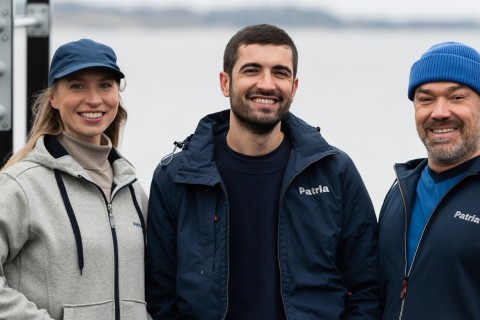
2.5.2016
A mortar is a simple and efficient weapon for indirect fire. A barrel, a base plate and a grenade – already for a century. However, on the modern battlefield, the mortar is vulnerable. The modern Patria Nemo provides protection, mobility and versatile firing capability, including direct fire.
Text: Tero Tuominen
World-class mortars have been manufactured in Finland since 1933. They have also found their way onto international markets. Mortars such as the 120KRH92, which supports infantry combat operations , continue to be in active use by the Finnish Defence Forces. However, traditional mortars are becoming defendants. If the enemy has counter-radars capable of pinpointing the location of the mortar, the mortar crew can expect accurate counter-fire to be directed at its own firing position. Escaping from such counter-fire is hard for a traditional mortar platoon. A simple solution is to mount the mortar on the chassis of a vehicle, on the floor. This will add improved mobility. Furthermore, if the vehicle is armoured and the mortar is mounted on a turret and equipped with a fire control system, the weapon system will have high performance in the modern battlefield.
The introduction of a stub case revolutionised the mortar
In 1995, Patria initiated collaboration with Swedish Hägglunds to bring the 120mm mortar into the modern era. The result was AMOS (Advanced Mortar System), a twin-barrelled system designed for mounting on a vehicle. The first version represented the traditional muzzle-loaded design. Patria was responsible for the development of the weapon and Hägglunds for the turret with its auxiliary systems. The breech loading mortar became possible after Patria developed a stub case solution. As its name suggests, it is short, in other words, a mere stub. When the stub case is attached to the tail of the mortar grenade, the mortar can be equipped with a vertical sliding breech block, turning it into a breech-loaded weapon. After the weapon is fired, the stub case is ejected into a collector mounted on the vehicle. Due to its breech loading capacity the turret-mounted mortar is capable of firing also at low elevation angles and is even suitable for direct fire, providing possibilities to use the mortar against a variety of targets. The turret-mounted system has a recoil system, which reduces the recoil forces in the vehicle. After a fire control system and a semi-automatic loading was added to the system in the year 1997, the AMOS TD was born.
The Finnish Defence Forces have later acquired the AMOS system mounted on the armoured Patria vehicle XA-361 AMV 8x8 (Armoured Modular Vehicle).
Suitable for a marine environment
The Finnish Defence Forces have later acquired the AMOS system mounted on the armoured Patria vehicle XA-361 AMV 8x8 (Armoured Modular Vehicle). This vehicle has a crew of five: driver, commander, gunner, and two loaders. Mortar bombs are stored in an ammunition storage in the rear of the vehicle. The typical number of bombs varies from 40 to 60. The commander uses the fire control system, the colour displays of which provide an overview of the tactical situation and the status of the weapon. The system enables automatic ballistic calculations and aiming of mortar fire according to the mission, taking into account also weather report. Protection and mobility are not the only positive aspects of the turret-mounted mortar system. “The savings in the amount of needed crew compared to traditional mortar units are substantial, reaching up to 60%,” comments Kari Reunamäki, Vice President, Weapon Systems, Patria Land business unit. AMOS system has also been offered to Sweden, as its future mortar solution. “Choosing this system would bring natural synergies to the defensive collaboration between the two countries, which is in the process of deepening” says Reunamäki, stating his firm belief in the issue. The twin-barrel AMOS has high fire-power, but the weight of the turret is quite high, around 3,600 kilos. AMOS can also be installed on vessels. Reflecting this capability, the system has been tested in Sweden, mounted on Stridsbåt 90 boat. This stabilised mortar is also capable of firing on-the-move. However, the weight of the twin-barrelled mortar restricts the ammo carrying capacity in smaller vessels, such as 12 metre Jurmo-class. Thus, Patria continued the development alone, which resulted in the single-barrel Nemo (New Mortar). Its low-signature remote-controlled turret, designed for stealth, weighs only 1,700 kilos. “The new and lighter Nemo is ideal for the new Navy Jehu-class troop landing craft,” says Reunamäki.
Shoot and Scoot
A mortar mounted on a vehicle capable of manoeuvring through rough terrain enables the vehicle to find a firing position quickly. It takes only 30 seconds for the vehicle to open fire after stopping. Similarly, after it finishes firing the vehicle can leave the firing position in just ten seconds. This is known as “shoot and scoot“. The mortar receives targeting information through the integrated communication system of the platform. The system determines its position with the aid of a GPS system, or its own inertia system. The fact that the mortar is mounted on a turret enables it to select its targets from a full 360 degree traverse and within a range of approximately ten kilometres. The elevation is -3/+85 degrees. Aiming of the weapon is electric, with a manual system as a backup. The maximum rate of fire for Nemo is 10 rounds per minute. The first three bombs are fired within 15 seconds, after which the continuous rate of fire is six rounds per minute. During the loading cycle, the mortar is automatically brought to a default loading position of 45 degree elevation. The loaders feed the grenade onto a loading device, from which the grenade is automatically rammed into the barrel. The mortar is then automatically aimed at the target.
Multiple Rounds Simultaneous Impact brings additional efficiency
The mortar’s automated fire control system facilitates the firing method known as Multiple Rounds Simultaneous Impact (MRSI). Using this method, several grenades are fired to different trajectories in such a way that they hit the target simultaneously. This maximises the impact at the target. The first bomb in a burst of fire is fired at a high elevation with a full propelling charge. The following bombs are fired at lower elevations and with increasingly smaller charges. The Nemo is capable of firing a burst of up to five grenades, all of which hit the target simultaneously. This method of firing, known as Multiple Rounds Simultaneous Impact, is not confined only to turret-mounted mortars. However, automated laying, fire control system and the possibility of using also low elevations make the MRSI much simpler to use than with traditional mortars, and enable a larger number of bombs hitting the target simultaneously.
Direct fire capability
Nemo and AMOS turrets are also capable of direct fire using their own sights, laser range finders and thermal imagers. This capability can be used for close-range fire support, in urban warfare and to defend the mortar vehicle up to a distance of one kilometre. Although a 120mm mortar is a rather traditional weapon, modern self-guided ammunition has been developed for it. Using such bombs, indirect fire can be combined with a precision impact. “Patria’s turret-mounted mortars have been used to fire Saab’s STRIX bombs, for example,” says Kari Reunamäki. Bombs with a heat seeking warhead and guidance system will find and targets on the battlefield. Nemo and AMV complement each other in Patria’s portfolio. They can be sold as an integrated package or, alternatively, a turreted mortar system can be mounted on a vehicle supplied by the customer or some other vehicle provider. For example, Saudi Arabia has acquired Nemo system mounted on a US-made LAV 2 vehicle. The United Arab Emirates, on the other hand, has mounted the mortar on a combat vessel. “There are opportunities for sales in many markets. However, arm deals with associated export licences are always a demanding process,” remarks Kari Reunamäki. “In many countries, the notion of using heavy mortars is not necessary part of their defensive strategy. We need to start from the basis, in other words, the usage of heavy mortars must be seen as part of the strategy.”
What did you like about the article?
Thank you for your opinion! You can share the article on social media using the buttons below:





























